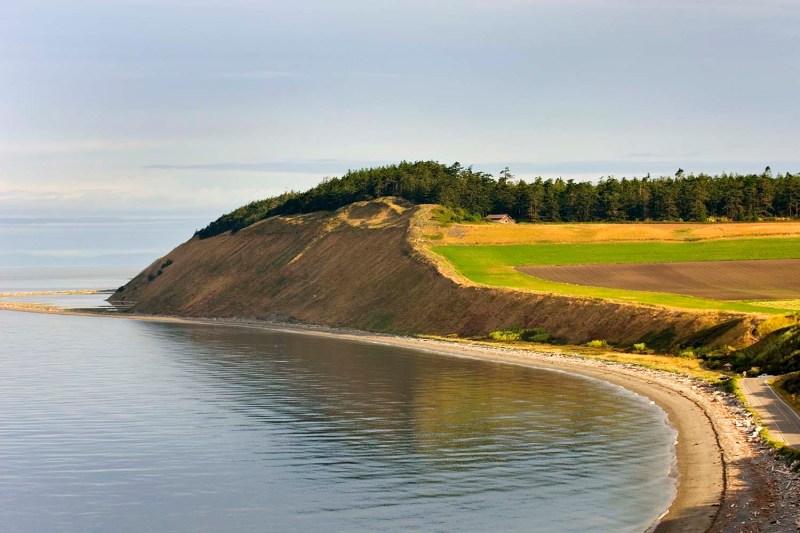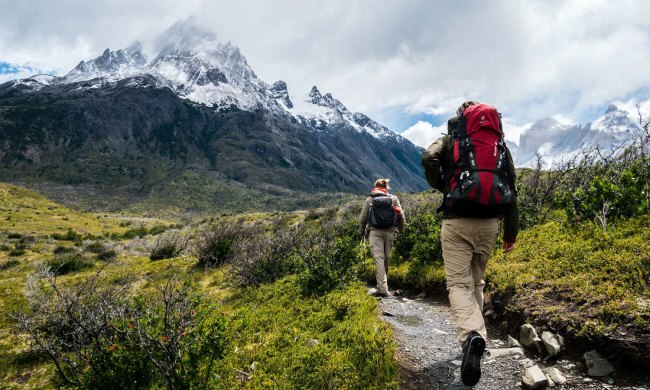
Look alive, outdoor lovers! November 17 (Sunday) is National Take a Hike Day.
While some might question the wisdom of designating this holiday smack in the middle of shoulder season, we think it’s actually a stroke of genius. Nothing proves the mettle of a professed outdoor adventurer like hitting the trail during nature’s most temperamental and arguably least attractive time. As Marilyn Monroe said, “If you don’t love me at my worst, you don’t deserve me at my best,” and the same goes for your favorite woodland rambles and mountain ascents. So save the sweatpants and Netflix for another weekend, and take the opportunity to immerse yourself in nature this Sunday on National Hiking Day.
Our Favorite Hiking Trails
Atalaya Mountain Trail in Santa Fe, New Mexico
Start from the beautiful campus of St. John’s College, just outside downtown Santa Fe, and begin your climb through a tangle of piñon scrub and ponderosa pine up to a 2,000-foot summit known as the “Watchtower” in Spanish. Along with a gorgeous view of the mountains and Santa Fe’s spread of quaint adobe dwellings, this hike also offers the benefit of options: You can take a gradual route or a steeper route, stop at the summit, or continue on to Picacho Peak for an even better view.
Grassy Ridge Bald in Asheville, North Carolina
Photographers take note: The sweeping golden grass that covers this Appalachian “bald” serves as a natural light reflector, turning you, your companion and everything around you into a scene out of a rural romance novel. The climb along Roan Mountain is long (about 4.7 miles) but gentle, with plenty of switchbacks to stop and catch your breath. Just prepare to have it taken away again when you reach the infinity views of the Blue Ridge Mountains at the trail summit.

Chickie’s Rock in Lancaster, Pennsylvania
This trail follows an old trolley line route from the 1900s that took tourists up to Chickie’s Rock. This tree-lined uphill pathway is short and only moderately challenging, which makes the view at the top all the more mind-blowing: the path stops short at a cliff towering above the winding Susquehanna River. Try to arrive just before sunset and you’ll see the landscape as you’ve never seen it before, a painting come to life under the shifting light and shadows.
Mount Baldy in Keweenaw Peninsula, Michigan
Named for the summit’s bare mile-long ridge rimmed with contorted conifers, this hike is one of the only natural balds in the Midwest. The terrain includes a couple of steep elevation sections, and is sometimes flooded in sections, making the hike frequently … adventurous, shall we say? It ends with a 360-degree spectacle that includes the thick birch and maple forest on one side and the vast expanse of Lake Superior on the other. Keep an eye out for the red-roofed Eagle Harbor lighthouse, as well as bald eagles, hawks and other raptors wheeling overhead.
Ebey’s Landing in Seattle, Washington
Just an hour north of Seattle, Ebey’s Landing National Historic Reserve is the perfect slow-and-steady hike, with 5.6 miles of trails to wander but just 260 feet of elevation gain. Keep an eye out for birds above and whales on the horizon. Even if you don’t see any, the stunning views of the Salish Sea and Olympic Mountains will be plenty rewarding.

Tangerine Falls Trail in Santa Barbara, California
Built off a pathway used by the native Chumash people, this trail is named for a waterfall that may or may not be running during your National Hiking Day excursion. But who cares? There’s plenty more to enjoy on this 2.5-mile ramble through Los Padres National Forest, including 875 feet of elevation gain, a rocky creek running alongside the trail, a few rock hopping and scrambling opportunities, and ocean views all along the way.
Safety Tips
- Check the weather forecast right before you go, even if you checked it yesterday. November can bring big swings in weather conditions. This doesn’t mean you have to stay home if something changes, but it’s best to be prepared.
- Before embarking on your trip, have a Plan B and C just in case. Rain- and snow-flushed waterways flow higher and faster and can cause big changes in the landscape, including your trail. Don’t attempt to wade across moving water, and keep an eye out for loose rocks or mud that could cause you to slip. Bring a pair of hiking poles just in case.
- Even if the forecast calls for sun, the microclimates in a mountain, desert or woodland environment could bring unexpected rain, snow showers, or thick fog. Make sure to dress in layers and wear waterproof, high-traction boots.
- Wear a good base layer to keep your body temperature constant, a mid-layer for insulation, and a packable waterproof outer layer that you can strip on or off as needed.
- Keep an eye out for wildlife and poisonous plants. If you’re not familiar with the area’s flora and fauna, look it up on your drive to the trailhead.
- Bring a headlamp, water, and sunscreen (even if it’s cloudy), and let people know where you’re going and when you intend to be back.
Gear Recommendations

Janji Runpaca Long-Sleeve Tee: The organic cotton and alpaca fleece in this athletic tee blend into a heavenly softness against your skin. It’s also thermo-regulating to accommodate just about every temperature, and (crucial in a base-layer) odor-resistant even after multiple days of use.
Icebreaker Descender Hydbrid Midlayer: This ingenious midlayer keeps your core warm with wool-based MerinoLOFT insulation in the chest and shoulder panels, while fleecy-soft, quick-drying terry corespun fabric (merino wool wrapped around a nylon core) in the back and sleeves lets you laugh at the threat of rain.
Cotopaxi Fuego Down Vest: Versatile, lightweight, and made with responsibly sourced, RDS-certified down, the Fuego vest slides easily between your base layer and jacket for the perfect amount of warmth without bulk.
Arc’teryx Zeta LT Jacket: The perfect emergency shell for hiking in changeable weather conditions, the Zeta packs up small but offers big-time protection. The minimalist design and fully articulated patterning also offer great freedom of movement.
Fjallraven Vidda Pro Pants: These badass trekking trousers are built from Fjallraven’s legendary G-1000 fabric, a wind- and waterproof mix of polyester and cotton canvas that comes into its own when impregnated with Greenland Wax (see below). With double-layered seat and knees and six cargo pockets, these wilderness-ready pants are cut to make your butt look great.
Mammut Ducan High Gore-Tex Shoe: We’re obsessed with the construction and agility of this badass hiking shoe. Built around the Mammut Flextron technology which integrates a spring-steel sole as a midsole, it also features an asymmetrically laced GORE-TEX mono-tongue that does double-duty to keep moisture out.
Black Diamond Trail Ergo Cork Trekking Poles: Ultra-comfy, sweat-wicking handles made from natural cork are the sweet spot of these versatile, lightweight poles. The Dual FlickLocks provide custom adjustability, and the interchangeable Tech Tips can be swapped between carbide and rubber, depending on the conditions of your chosen trail.


